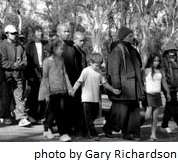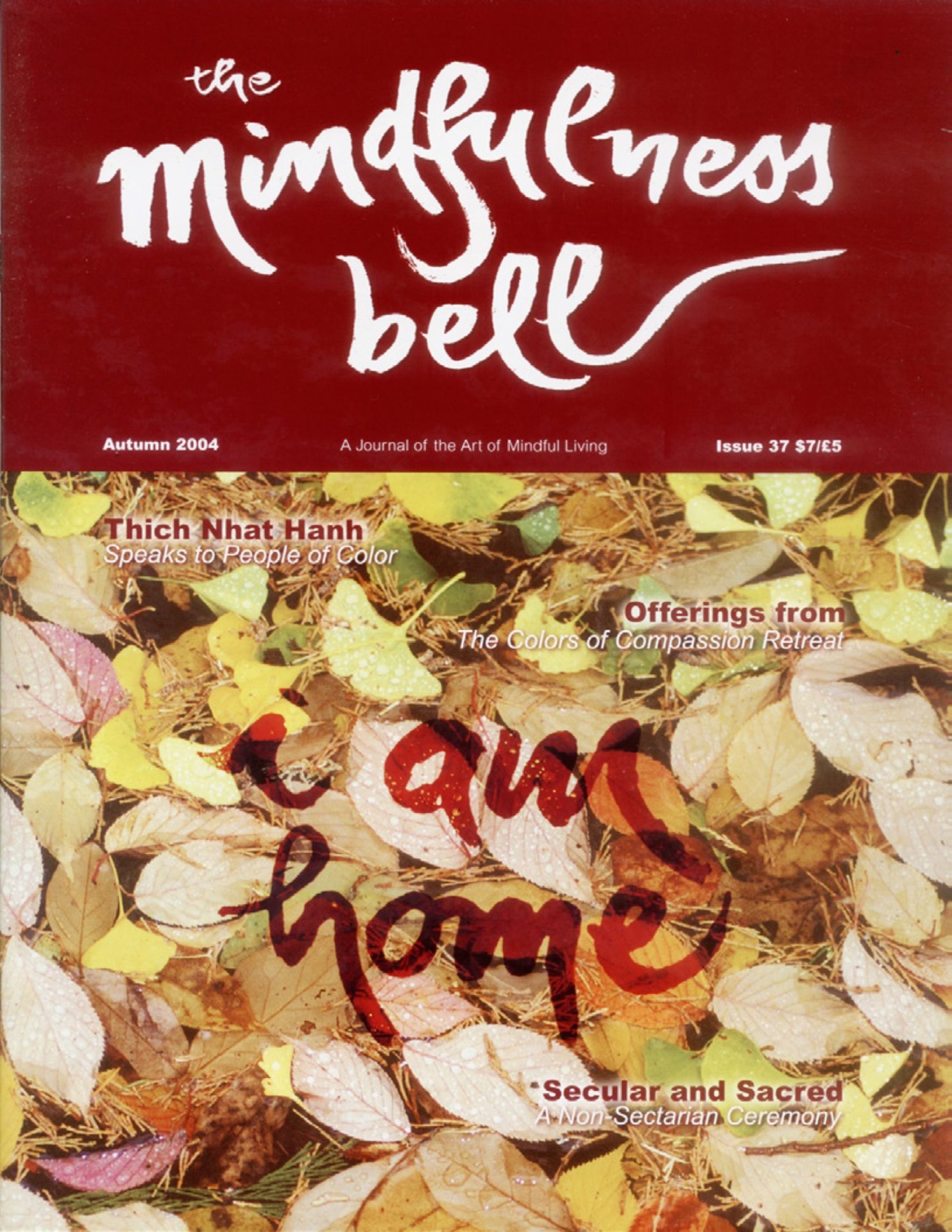At the Colors of Compassion Retreat
In March, 2004, at the Colors of Compassion retreat, Thich Nhat Hanh addressed questions from two participants who are part of the group described in the article on page 23.

My name is Aaron, I’m from Boston, Massachusetts, I’m seventeen. Where I’m from it’s a more urban setting, and a lot of us kids are faced with feeling like we’re hopeless because a lot of problems that we have seem to just badger us and don’t go away.
At the Colors of Compassion Retreat
In March, 2004, at the Colors of Compassion retreat, Thich Nhat Hanh addressed questions from two participants who are part of the group described in the article on page 23.

My name is Aaron, I’m from Boston, Massachusetts, I’m seventeen. Where I’m from it’s a more urban setting, and a lot of us kids are faced with feeling like we’re hopeless because a lot of problems that we have seem to just badger us and don’t go away. Everywhere you turn there’s a negative. Your friends peer pressure you to smoke weed or they might ask you: “Hey, I got problems with somebody, can you help me beat ‘em up?” And where I’m from, due to the facts of the streets, it’s almost a responsibility you hold for your friends. But you got so many negatives coming at you from each side, how can you use mindfulness and Buddhism to turn those negatives into a positive?
I think the first thing you must do is to create a place where people can feel safe. This is the work of Sangha building. You create a community where people know how to practice mindful breathing, mindful sitting, mindful walking; where people know how to handle their emotions and feelings. When that Sangha meets regularly and practices together, then you can invite other people. And when they come they feel safe, they feel that there is something beautiful and peaceful. They calm down and begin to see more clearly. The Sangha must help us get a taste of peace, of joy, of brotherhood through the practice. Then we can choose to go in the direction of peace.
You use drugs when you don’t know how to handle the suffering inside you. When the despair, the anger, the anxiety comes up, you get some drugs or alcohol in order to forget. Instead we can offer a Sangha of practice, and teach people how to handle the blocks of suffering inside. In the practice center we learn how to take care of our body by the practice of mindful eating and mindful drinking. We learn how to take care of our feelings and emotions when they manifest.
In the Sangha there should be people who have really mastered the practice, like a Dharma teacher or a long-time practitioner. Then we invite people over for tea and for a discussion, and they will experience the atmosphere of peace and safety. In Boston the young people who know how to practice can start a Sangha for young people. My answer is Sangha-building.
I’m also from Boston, Massachusetts. I came here to learn more about Buddhism and how you live your life here. I see now that it’s so beautiful, everybody welcomes everybody. Where I come from there’s not a lot of that. There’s a lot of negativity and discrimination. I’m eighteen, and teenagers my age go through so much in Boston, and most don’t know about Buddhism. They don’t know how to deal with their suffering. Is there a way that I can talk to my friends and help them understand this practice?
The living Dharma, the teaching of the Buddha, is a way of life that radiates peace, understanding, and compassion. That is why it is very important to show people the living Dharma and not just the Dharma in a book or a tape. People have made the teaching of the Buddha complicated, but in fact we can talk about it and we can show it to friends in a very simple way.
Thanks to the true practice, we can radiate the energy of gentleness, peace, and compassion, and others will feel it right away. That is the best way to introduce the Dharma to them. We have learned to touch the nobility in ourselves, the seed of understanding and compassion that exists in everyone. And when we talk to people, we can touch the seeds of compassion, joy, and understanding in them. Then these seeds will manifest as energies that help them feel much better. We need to train ourselves a little bit in order to do that.
In the teachings of the Buddha it is very clear that what is valuable in a person is not their race or caste, but their thought, speech, and action. You are noble not because of your race, but because of your way of thinking, your way of speaking, and your way of acting.
According to the teaching of the Buddha, everyone has the seed of equanimity within himself or herself. Equanimity means nondiscrimination. If we are able to touch our own seed of equanimity, the wisdom of nondiscrimination will manifest, and we will not suffer and make others suffer. Everyone has the seeds of joy and compassion in them, and if you know how to touch them you transform them into energies that make you feel happier, more joyful, more compassionate. The practice of watering seeds can bring such results right away.
You know the other person has the seed of joy and compassion in her. Suppose you talk to her in such a way that you touch those seeds, and half an hour later she becomes a different person. This is possible. You also know that she has the seeds of sorrow, despair, and jealousy in her. So you refrain from watering those seeds and you only recognize and water the positive seeds in her. In no time at all she becomes more pleasant, happier. This is not only for her sake but for our sake, and we call this the practice of selective watering.
I see young people who come home from a retreat transformed. Thanks to their true presence, which embodies the Dharma, the same aspiration and energy is born in their parents, and they embrace the practice and change themselves. Then the family is completely transformed. This is what I call the living Dharma. You can embody the living Dharma through this practice.


